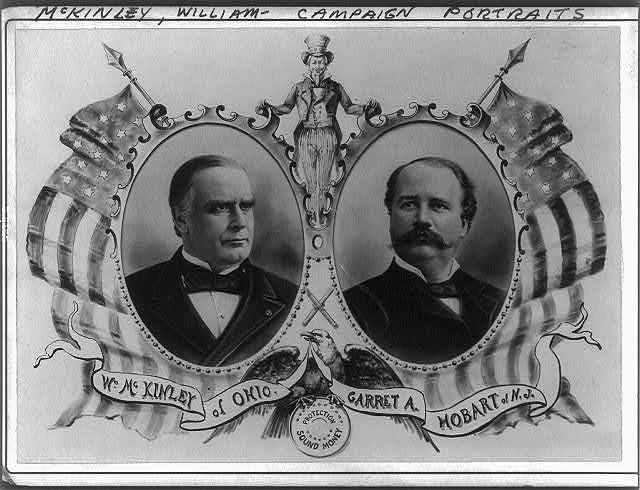McKinley & Hobart Honest Money Ribbon | Circa 1896








McKinley & Hobart Honest Money Ribbon | Circa 1896
Frame Size (H x L): 10” x 7”
Flag Size (H x L): 5.5” x 2.25”
Offered is a thirteen-star flag ribbon made of silk. Below the flag is the following overprint:
McKINLEY & HOBART
HONEST MONEY.
McKinley was the presidential nominee for the Republican Party in 1896. His most formidable opponent was William Jennings Bryan, who was the nominee for the Democratic Party. McKinley defeated Bryan. McKinley won 271 electoral votes and 51% of the popular vote, while Bryan won only 176 electoral votes and 47% of the popular vote. McKinley was a proponent of the gold standard and “honest money.” In contrast, Bryan was a proponent of the free coinage of silver, despite inflation concerns related thereto.
Thirteen-star flags were commonly used during the Mexican War in 1846-1848 and the Civil War in 1861-1865. They were both relatively close in time to the revolution, and were very patriotic times, particularly during the Civil War time period when flag use became much more common than had ever previously been the case. Thirteen-star flags were also flown during the centennial celebrations, which were held across the country and, most notably, in Philadelphia at the Centennial International Exhibition.
The original use of the thirteen-star flag dates to June 14th, 1777, the time at which the Continental Congress adopted a resolution creating the first official flag. The resolution stated, “Resolved, that the flag of the United States be made of thirteen stripes, alternate red and white, that the union be thirteen stars, white on a blue field, representing a new constellation.” Thirteen-star flags were official from 1777-1795, but have been in use ever since.
Small US Navy boats used it as the ensign from 1795 until 1916. Thirteen-star flags were also flown at the time of George Washington’s death in 1799 and to celebrate the nation’s 50th anniversary in 1824. They were also flown in 1824 in honor of General Lafayette’s return to the US for his nationwide tour. Celebrations for his Revolutionary War service were held in New York, Boston, and Philadelphia, along with many locations in the southern and western states.
Conservation Process: This flag is sandwiched between Optium Museum and cotton fabric. To prevent the black dye in the cotton fabric from seeping into the flag, it was first washed in a standard wash and then in a dye setting wash.
Frame: This flag is in an antique walnut frame, dating to between 1860 and 1890.
Condition Report: The flag is in excellent condition.
Collectability Level: The Good – Perfect for Beginning Collectors and Gifts
Date of Origin: 1896
Number of Stars: 13
